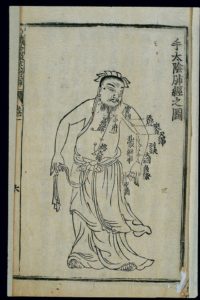Explanations of Channels and Points Vol.1 -Point Explanations I
______________________________________________

The following post is an excerpt from《Explanations of Channels and Points Vol. 1》 translated by Michael Brown, and edited by Allen Tsaur. It explicates the origin of point names from a new perspective and viewpoint.
Lung
First Point of the Lung Channel
Zhōng Fǔ – Central Administration [1] (LU-1)
肺經第一穴中府
注:此穴為肺之募。募者,結募也。言本經之氣聚於此穴也,乃手,足太陰,脾,肺二經相會之地。
Explanation: This point is the collecting [point] of the lung. Regarding the collecting [points],[2] [this is where the qì] binds and collects. It is said the qì of this channel gathers at this point, thus the hand and foot tàiyīn, the spleen and the lung, these two channels meet at this location.
以足太陰脾經周榮穴,在中府穴下一寸六分,上下相值,肺經在上,脾經在下而相遇,故為二經聚會之所。中府云者,以此穴為本經聚氣之府也。
This is because Zhōu Róng (SP-20) of the foot tàiyīn spleen channel, which is located 1 cùn 6 fēn below Zhōng Fǔ (Central Administration). Here the upper and lower mutually coincide – the lung channel is located in the upper, the spleen channel is located in the lower – they encounter each other; thus, this is the place where the two channels gather and meet. Zhōng Fǔ (Central Administration) is called as such because this point is the Fǔ (Administration) where this channel gathers qì.

Second Point of the Lung Channel
Yún Mén – Cloud Gate (LU-2)
肺經第二穴雲門
注:穴名雲門者,天之氣爲雲,肺為五臟之華蓋,而居五臟之上,有天之象焉,其所出氣者,有雲之象焉。
Explanation: this point is named Yún Mén (Cloud Gate) because the qì of heaven are the Yún (Clouds); and the lung is the florid canopy of the five zàng-viscera, residing in the highest position of the five zàng-viscera, with the image of heaven. It is the place where qì exits, so it is comparable to the image of clouds.
自肺經而上行至此穴,為本經最高之所,將離胸而入臂之内,必有竅以通于臂,有門之象焉,故曰雲門。
The lung channel from [the middle jiāo] ascends to reach this point, as the highest place of this channel. It then departs from the chest to enter the inside of the arm,[3] therefore [there] must be an opening in order to connect to the arm. It has the image of a Mén (Gate), therefore it is called Yún Mén (Cloud Gate).

[1] Grasping the Wind names this point Central Treasury. For this translation, English name of the points mostly refer this work; however, in instances where Yuè Hánzhēn’s explanation differs from its interpretation, the name would be re-translated based on Yuè’s interpretation.
[2] Collecting points募 are called alarm points, or front-mu points.
[3] 臂 usually means the forearm, but in this incidence, it appears to mean the upper arm.
________________________________________
Post-Scriptum: The book is available on amazon under the following link:
PPS: Vol. 2 will be released next year.
Would you like to subscribe to our newsletter?
If you enjoyed reading this please consider supporting us!
When we started the Purple Cloud Institute, our aim was to make accessible educational material about traditional Chinese cultural practices. We strive to keep prices of our books as affordable as possible and the content we provide free of charge. However, there are many ongoing behind the scenes costs and the time taken to provide such content is considerable.
If you have enjoyed our offerings please consider donating and supporting us. The help will allow us to make time to bring you more in the way of book publications, podcasts and videos about tradition-based Daoist, Chinese medicine and martial arts and help keep these traditions alive.
Your assistance is greatly appreciated!
